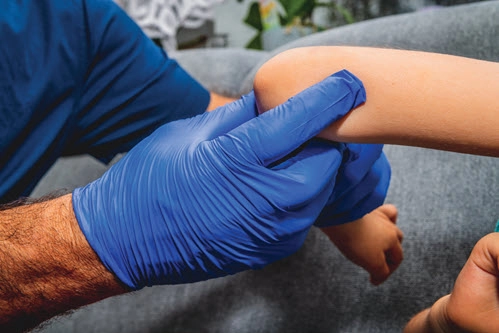Hint: Don’t code these similar encounters the same way twice.
Your pediatrician may refer to it as a radial head dislocation. They may even use a more clinical term: a subluxation. But for most of us, the injury is more commonly known as nursemaid’s elbow, so called because the injury occurs “when a child is pulled up too hard by their hand or wrist… often [when] someone lifts a child up by one arm,” according to Medline (Source: medlineplus.gov/ency/article/000983.htm).
The injury itself is common enough, but coding it still requires precision on your part as a coder. Especially when the kind of scenario outlined below occurs.
The Scenario
A mother comes to your office with her 4-year-old son who is established to the practice. He has dislocated his right elbow falling from the jungle gym in their local playground. Your pediatrician examines the boy and confirms the dislocation, then gently moves the boy’s bone and ligaments back into place. One week later, the mother brings the boy back as he is complaining of the same problem. You pediatrician confirms that the boy’s right elbow is again dislocated and performs the procedure once more.
Coding the First Encounter
Fortunately, assigning a diagnosis code in this situation is relatively straightforward, as the ICD-10 index and the code descriptor both use the more common name for the injury. So, you will code the injury as S53.03- (Nursemaid’s elbow). As you know the dislocation is the right elbow, you will add a sixth digit, 1, and as this is the boy’s first encounter with your pediatrician for the injury, you will also add a seventh character, A, to indicate this is the initial encounter.

Then, whether or not insurance and/or state mandates require you to report one or more external cause codes along with the principal diagnosis code, “this initial visit would also benefit from adding W09.2XXA [Fall on or from jungle gym, initial encounter]” advises Jan Blanchard, CPC, CPMA, pediatric solutions consultant at Vermont-based PCC. And you can also add Y92.830 (Public park as the place of occurrence of the external cause) to describe where the injury occurred, making sure neither code is first listed.
The procedure itself should be billed with 24640 (Closed treatment of radial head subluxation in child, nursemaid elbow, with manipulation), and if the procedural notes justify it, you will also bill for a separate evaluation and management (E/M) service along with the 24640. In all likelihood, given that the condition is a self-limited or minor problem, that your pediatrician will have minimal or no data to review or analyze, and that the risk of the closed reduction to the patient is minimal, the level of the E/M would be 99202/99212 (Office or other outpatient visit for the evaluation and management of a new/ established patient, which requires a medically appropriate history and/or examination and straightforward medical decision making …).
Mind the Modifier!
If you do bill the procedure and E/M together, however, you will need a modifier on the 99202/99212. But which one?
If you’re tempted to reach for modifier 57 (Decision for surgery) because the E/M service resulted in the patient’s same-day treatment, you might want to think again. That’s because modifier 57 is reserved for E/M services that result in major procedures — procedures that have a global postoperative period of 90 days.
The global package for 24640, however, is only 10 days, making it a minor surgery that you would separate from the E/M by using 25 (Significant, separately identifiable evaluation and management service by the same physician or other qualified health care professional on the same day of the procedure or other service) on the 99202/99212.

Coding the Second Encounter
Though the two encounters seem similar, you’ll actually code them differently. One thing that won’t change, however, is the diagnosis code. Even though this is a second encounter, you would not use seventh character D to indicate it is a subsequent encounter. As this character is used during the healing process for an injury, and the injury is still in the treating process during the second encounter, you’ll still use A as the seventh character and code S53.031A again.
You’ll also record W09.2XXA a second time, but you can omit the place of occurrence. That’s because, as American Academy of Pediatrics (AAP) reminds you, “when coding for an injury where the external cause is not within the code itself… you will only code for the external cause throughout the length of the injury. The place of occurrence, activity and status are only at the initial injury encounter (ie, only reported once per injury). Therefore… your office would not code the additional details, only the external cause” (Source: www.aap.org/en-us/Documents/coding_faq_coding_encounters_icd_10.pdf).
You will also have to report 24640 a second time for this encounter. You would do this because “even though CMS assigns a 10-day global period to 24640, the repeat procedure is not regarded as follow-up care,” advises Blanchard. This means you will have to add a modifier to the 24640 on the second encounter.
“The repeat may be paid by payers if modifier 76 [Repeat procedure or service by same physician or other qualified health care professional] is appended to the second 24640,” says Blanchard. Some payers may even prefer modifier 78 (Unplanned return to the operating/procedure room by the same physician or other qualified health care professional following initial procedure for a related procedure during the postoperative period).
As for a second E/M? “That will depend on the clinician’s judgement, as the patient may or may not require reevaluation and management for the condition,” Blanchard believes. So, depending on the note, you may or may not add 99202/99212-25 a second time around.
